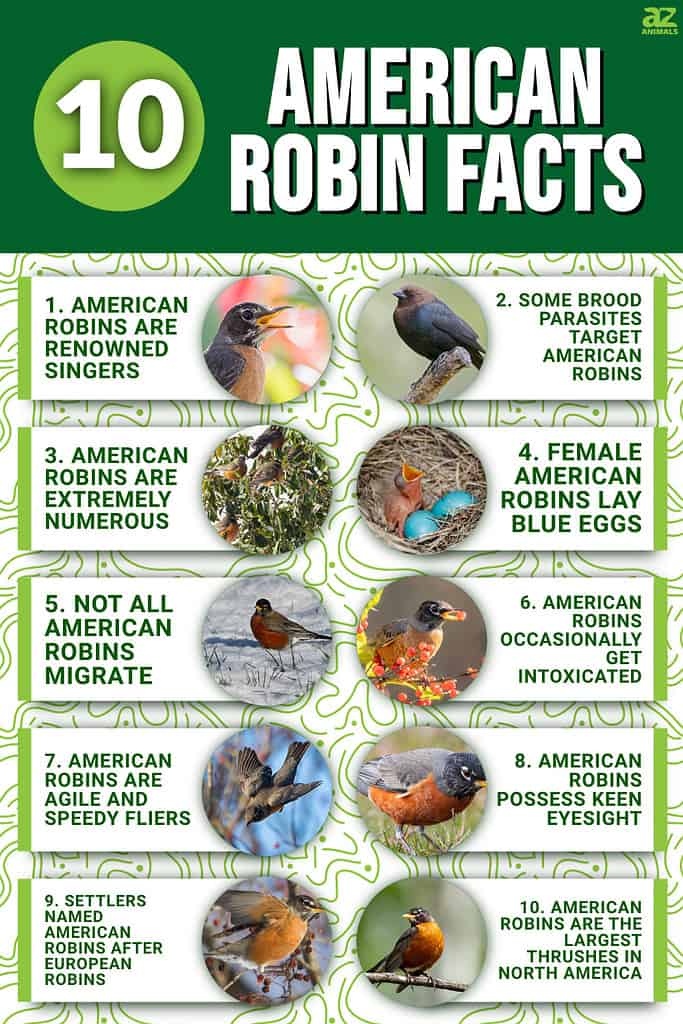
The American robin, Turdus migratorius, is one of the most common and iconic birds in North America. A member of the thrush family Turdidae, it ranges throughout the continent from Canada in the north to Mexico in the south. It’s well known for its red breast and dark hood and is a common sight in backyards and parks. Here is a list of 10 American robin facts that delve into what makes these birds so extraordinary.
10. American Robins Are the Largest Thrushes in North America

American robins are the largest members of the Thrush family.
©Anna Richard/iStock via Getty Images
As previously mentioned, American robins belong to the thrush family, Turdidae. The family includes a large number of species that range throughout the world. They range in size from tiny birds that weigh barely more than an ounce to larger specimens such as the great thrush, which measure between 4 and 6 ounces.
Among thrushes in North America, the American robin stands head and shoulders above the rest. On average, they measure larger than other North American thrushes, including bluebirds, wood thrushes, and hermit thrushes. Most specimens measure between 9 and 11 inches long, with a wingspan between 12 and 16 inches. American robins average about 2.7 ounces, with males ranging between 2.5 and 3.3 ounces and females measuring 2.1 to 3.2 ounces.
9. Settlers Named American Robins After European Robins
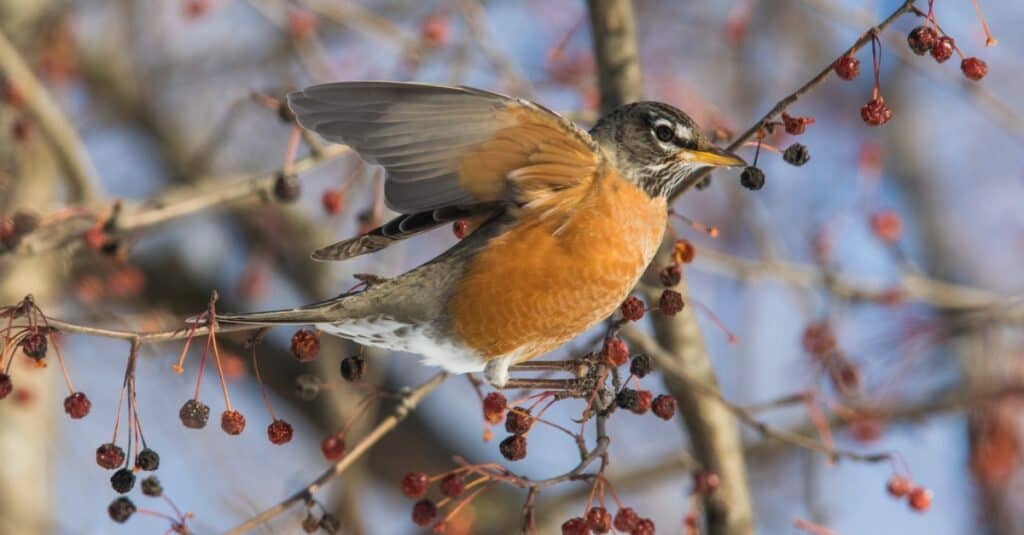
The American robin has darker feathers and longer wings than the similar-looking European robin.
©iStock.com/mirceax
The American robin’s scientific name – Turdus migratorius – comes from the Latin words for “thrush” (turdus) and “to migrate” (migrare). They resemble other thrushes in terms of their overall appearance, including rounded heads and relatively long, pointed wings.
When early settlers from Europe first arrived in North America, they quickly came to associate the American robin with a bird from their home countries. They decided to name the American robin after the similar-looking European robin. You can differentiate the two by the European robin’s lighter-colored feathers and shorter wings.
8. American Robins Possess Keen Eyesight
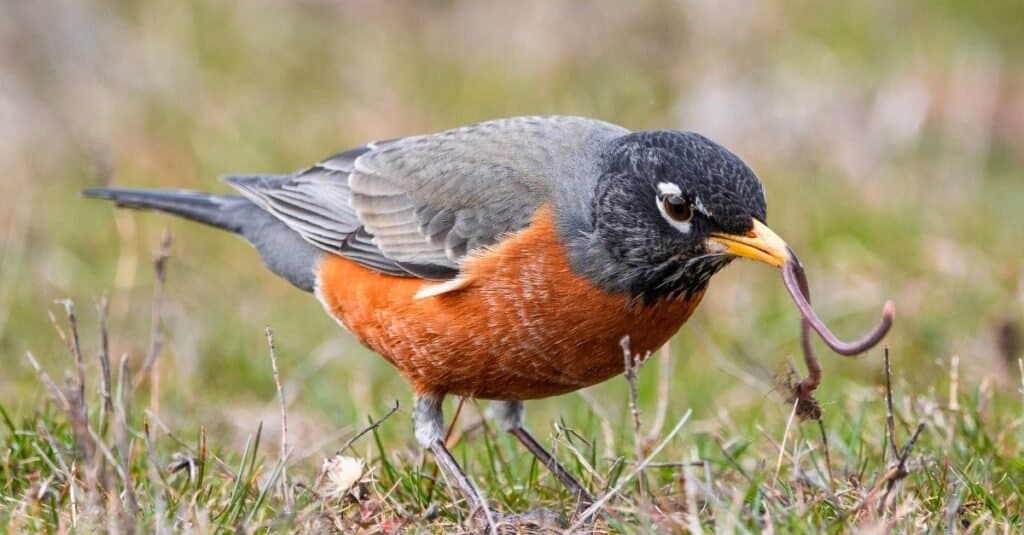
American robins can actually see the slight movement of the ground above a traveling
earthworm
.
©iStock.com/Mason Maron
Like many other birds, American robins are omnivores that eat a wide variety of foods, including seeds, nuts, berries, and insects. Earthworms also make up a large portion of their diet. They typically hunt during the day, as they need to be able to see their prey.
For years, researchers believed that American robins used their acute hearing to locate worms in the ground. Now, evidence suggests that they also rely on their eyesight. When foraging, American robins use their powerful monocular vision to see through each eye independently. This allows them to observe movement around them and hone in even on tiny invertebrates hiding just below the surface.
7. American Robins Are Agile and Speedy Fliers
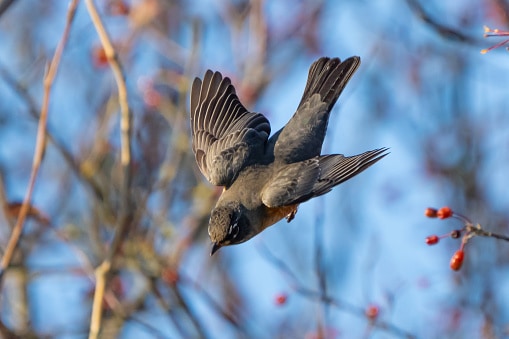
American robins are speedy flyers that can catch insects in mid-air.
©Jeff Huth/iStock via Getty Images
Typically, American robins find their food hanging from a tree or a bush or hiding amongst the grass. That said, they can and will also catch insects flying in mid-air. To accomplish such a feat, it stands to reason that American robins had to evolve into sturdy and dextrous aerial acrobats.
American robins can reach impressive speeds despite their relatively small sizes. At top speed, they can reach up to 35 miles per hour, although their speed is largely influenced by weather conditions. Additionally, altitude factors into the equation, as birds flying at higher altitudes tend to fly faster than those flying close to the ground.
6. American Robins Occasionally Get Intoxicated
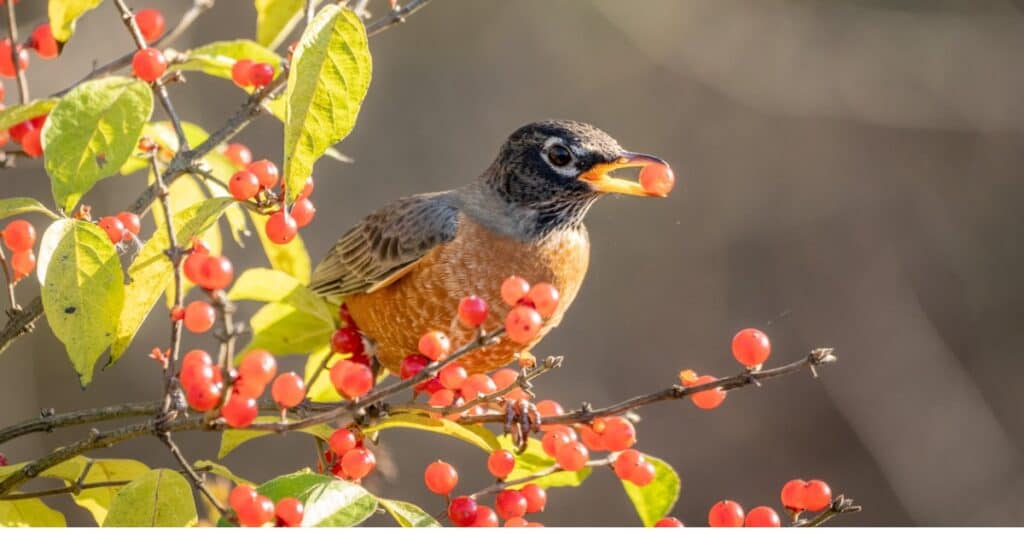
Fallen fermented fruit can lead robins to get intoxicated at times.
©iStock.com/weaver1234
Our next entry on our list of American robin facts is also one of the most surprising. As we’ve already discussed, American robins are omnivores that eat a wide variety of foods. Invertebrates comprise about 40% of their diet, with the remainder made up of seeds, nuts, fruits, and berries.
Due to the lack of insects available in winter, they feed almost solely on berries during winter. Given this diet, they also often eat a large amount of fallen, fermented fruit. This excess amount of fermented food can sometimes lead the birds to get intoxicated from the alcohol created during fermentation.
5. Not All American Robins Migrate
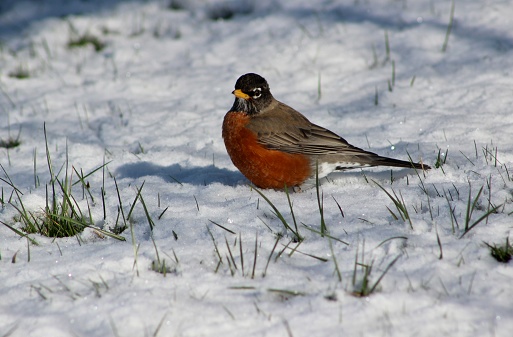
Some American robins choose to overwinter in northern regions of the United States and Canada.
©Mel S U/iStock via Getty Images
Given their scientific name, you’d be forgiven for assuming that all American robins migrate. After all, their name is Turdus migratorius, which translates to migrating thrush. However, the name is a slight misnomer, as the truth of the matter is that not all American robins migrate.
The majority of American robins travel south to winter in Florida, Mexico, and around the Gulf Coast. Some American robins migrate nearly 3,000 miles to reach their winter habitats. However, some populations don’t make this annual trip. Instead, they overwinter in northern parts of the United States and southern Canada.
4. Female American Robins Lay Blue Eggs
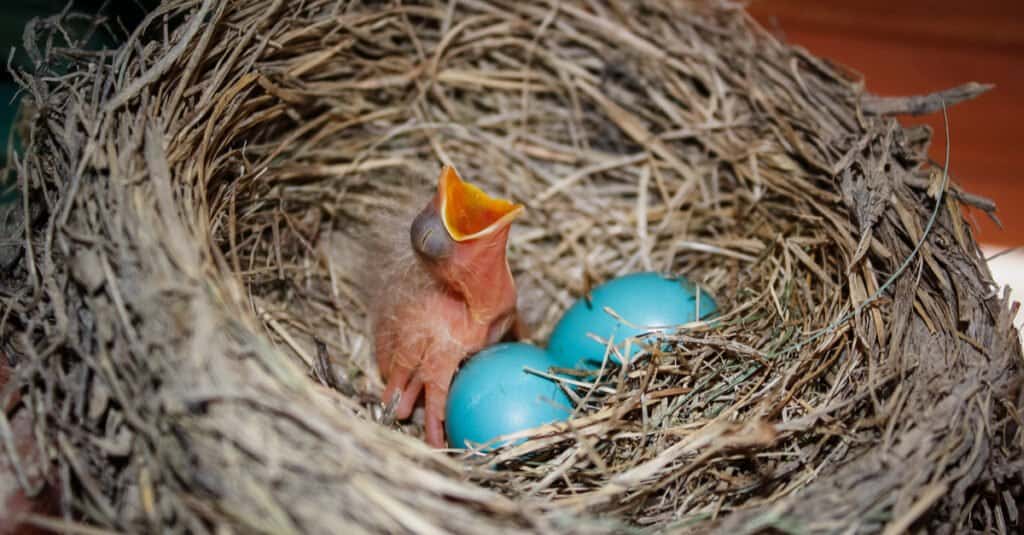
American robins lay blue eggs in a cup-shaped nest.
©Melinda Amburgy/Shutterstock.com
American robins can brood anywhere from 2 to 3 times per year. Although females are the ones constructing the nest, males arrive at the nesting area first. Females use a variety of natural materials to construct the nest, including twigs, grass, roots, and other vegetation. The cup-shaped nest is often also lined with delicate plant fibers and paper.
One of the most well-known and distinguishing American robin facts concerns the color of their eggs. These eggs are a remarkable light blue color, from which we get the phrase “robin’s egg blue.” Female American robins almost always lay four eggs. They lay one egg per day and will continue to care for their young even after they hatch and can leave the nest.
3. American Robins Are Extremely Numerous
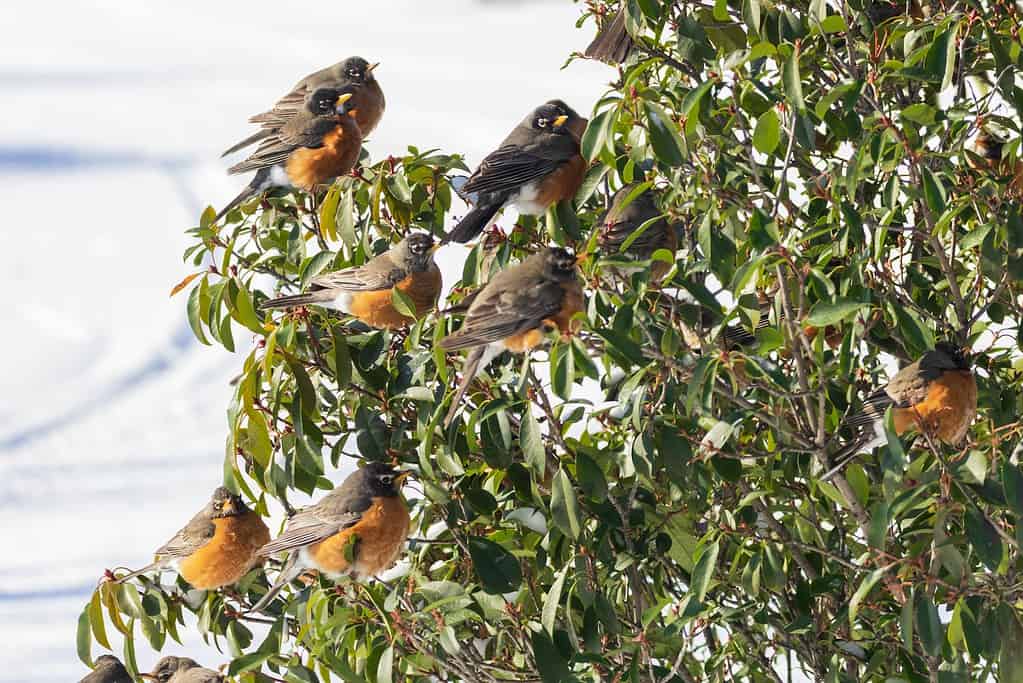
Robins tend to form large flocks in cold weather, sometimes in the hundreds or even thousands.
©Martina Sliger/Shutterstock.com
According to known information, there exist nearly 2,059 different bird species in North America. While estimates vary, researchers put the total number of birds in North America at around 10 billion. Those numbers are impressive, but what’s even more impressive is how American robins dominate the avian landscape across the continent.
American robins are one of the most widespread birds in North America. Some estimate that there are nearly 300 million American robins alive in the wild, making them the most common bird on the continent. Nearly 1 in 30 birds in North America is an American robin, and they often serve as a litmus test for the health of a local habitat.
2. Some Brood Parasites Target American Robins
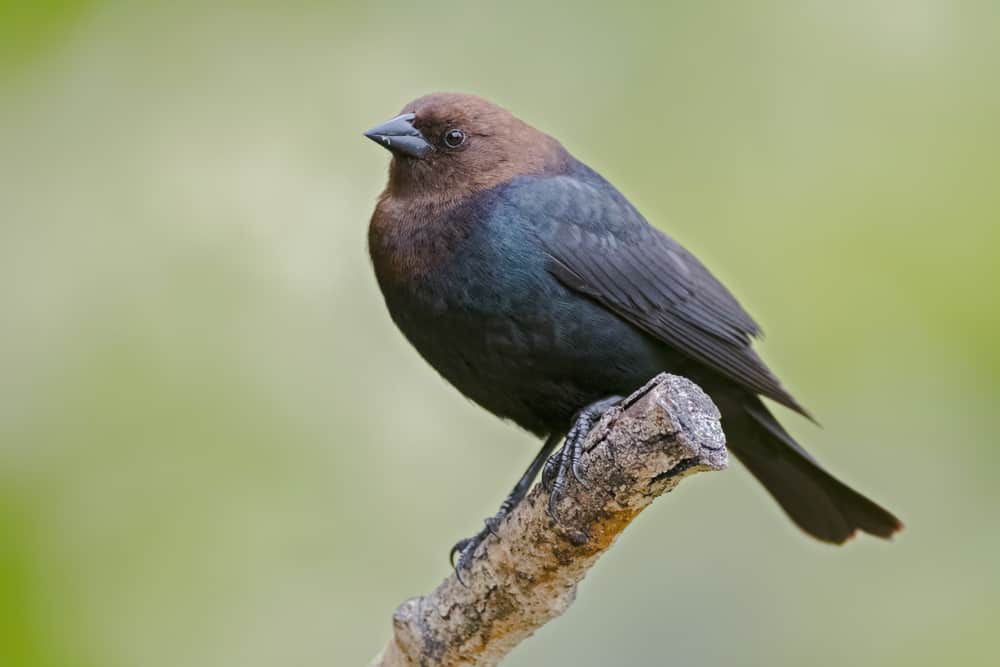
Brown-headed cowbirds often lay their eggs in American robin nests.
©punkbirdr/Shutterstock.com
Brood parasitism is a behavior that involves animals relying on other animals to raise their young. Numerous different species rely on this strategy, including a number of fish, insects, and birds. The practice is particularly well-known in birds, as different brood parasites employ a wide number of tactics to ensure their young reach maturity.
One notorious brood parasite species, the brown-headed cowbird, frequently lays its eggs in the nests of American robins. However, American robins often reject cowbird eggs. Even when they don’t, American robin parents rarely take care of the chick, so survival rates for cowbird chicks are low. Still, the practice continues, making this one of our darker American robin facts.
1. American Robins Are Renowned Singers

American robins are songbirds with songs that vary with the time of day.
©mirceax/iStock via Getty Images
The term songbird is used liberally to refer to any bird that makes pleasing sounds. However, the term specifically refers to birds in the suborder Passeri in the order Passeriformes. Like other songbirds, American robins are known for their complex and distinctive songs.
American robin songs vary by region, and the style also varies according to the time of day. You’ll usually hear American robins singing during the early spring and summer, although some birds will also sing in late summer.
The photo featured at the top of this post is © iStock.com/Mason Maron
Thank you for reading! Have some feedback for us? Contact the AZ Animals editorial team.






